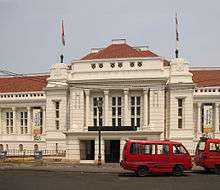Eduard Cuypers

Eduard Cuypers (April 18, 1859 Roermond – June 1, 1927, The Hague) was a Dutch architect. He worked in Amsterdam and the Dutch East Indies.
Cuypers was trained in the architectural practice of his uncle P.J.H. Cuypers and in 1881 set up his own office in Amsterdam. His good contacts with businessmen earned him commissions for offices, shops and houses. In spite of his training by his uncle, the country's major architect of neo-Gothic, his work was closely related to Neo-renaissance and Jugendstil. Although he designed several churches, unlike his uncle and his cousin Joseph Cuypers, Eduard did not confine himself solely to ecclesiastical architecture. Instead, he designed a few dozen railway stations, which were mostly built in the north of the country, several hospitals and many houses.
Cuypers and his employees also designed pieces of furniture and other objects for interiors, such as lamps. In 1905 Cuypers published Het Huis, Oud & Nieuw (The House, Old and New), a magazine for interior design that was published until he died in 1927. He was buried at Zorgvlied cemetery.
The office of Eduard Cuypers is considered as the origin of the Amsterdam School because the leaders of this style, Michel de Klerk, Johan van der Mey and Piet Kramer, were all trained there. Berend Tobia Boeyinga, one of the most important followers of the Amsterdam school, also worked for Cuypers for a while - as did the prominent Indonesian architect Liem Bwan Tjie.[1] After Cuypers died in 1927, his office was continued by others. The current name is A/D Amstel Architects.
Dutch East Indies
Cuypers opened an agency in the Dutch East Indies to work on major projects such as the headquarters and branch office of De Javasche Bank in Indonesia. With Marius J. Hulswit, Cuypers opened the largest architectural agency in the East Indies, then called Hulswit-Fermont, Batavia and Cuypers, Amsterdam.[2]
Work

- Javasche Bank, Jakarta (with Hulswit, 1909)
- Javasche Bank, Medan (1909)
- Office of the Nederlandsch Indische Escompto Maatschappij (1920)
- Volksapotheek te Rijswijk, now Kimia Farma at Jalan Veteran, Jakarta (1913)
References
- ↑ Suryadinata, Leo (2012). Southeast Asian Personalities of Chinese Descent: A Biographical Dictionary. Volume I & II. Institute of Southeast Asian Studies. pp. 573–574. ISBN 9814345210.
- ↑ Bambang Irawan (31 May 2014). "Berlage on Aperdi/Algemeene Building in Surabaya". Ayorek.org. Translated by Emily Wallace. Ayorek.org. Retrieved 16 September 2015.